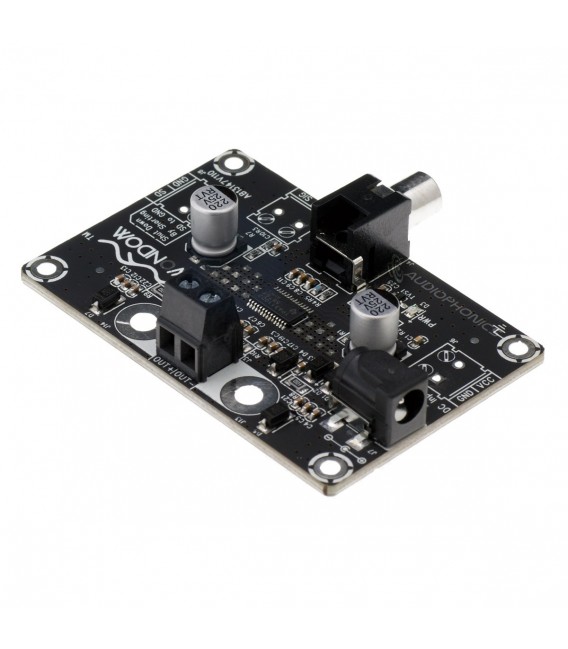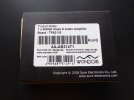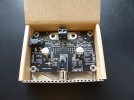Wondom AA-AB31471 1 x 30 Watt Class D Amplifier Board Review
1. Intro
I wanted to have a small audio system for my holiday trip, not to depend on usual TV set sound available at the hotels and pensions. As a speaker I would take my small JBL Control 1 Pro, so there was a question of the smallest but still good enough amplifier. I have excluded linear class AB amplifiers, even if I designed something it still would be too big and heavy. After some time spent with browsing I have decided to order this:

 www.audiophonics.fr
www.audiophonics.fr
1 x 30W class D amplifier board at incredible price of 14.09 EUR (without VAT). I placed the order and my price was 17.04 EUR (VAT included) + 11.70 EUR shipment, 28.74 EUR total. Like a single restaurant dinner, here.
The amplifier is based on TPA3110 circuit, using BD modulation type. Let's talk about class modulation principles a bit, as a start.
AD (Traditional) modulation

I have borrowed 2 images from literature [1]. The first one shows traditional AD modulation type.
The traditional switching technique (AD modulation) modulates the duty cycle of a rectangular waveform, such that its average content corresponds to the input analog signal. The bridge-tied load (BTL) outputs are the inverse of each other. AD modulation has no significant common mode content in its output. The TPA312xD2 family employs AD modulation.
BD modulation

The BD modulation switching technique modulates the duty cycle of the difference of the output signals such that its average content corresponds to the input analog signal. The bridge-tied load (BTL) outputs (see Figure 6) are not the inverse of each other. BD modulation has significant common mode content in its output, which creates stronger EMI interference signals. However, as there is little energy at the output for the zero signal, this kind of modulation can work without the output LC filter, resulting in a filterless design. The module under test uses this BD type modulation.
The PWM signal for AD modulation takes only two values, e.g., plus/minus supply voltage, and hence it is also referred to as binary modulation. By contrast, the PWM signal for BD modulation takes three values, e.g., plus/minus supply voltage and ground, and so is named ternary modulation.
Below is the simulation of class D amplifier with BD modulation.

2. Wondom AA-AB31471 amplifier board
The amplifier has arrived in this neat cardboard box:


Specifications are as follows, per manufacturer's datasheet [3]

We only need a 10V – 19V dc single polarity power supply, input RCA cable and a speaker to start to listen to the music. I am using a PC notebook SMPS power supply as shown in the next image:

The amplifier uses no heatsink, only copper plate of the PCB board. It is the BD modulation and high IC efficiency that allows this approach. The amplifier board is very small, 76 x 50 mm only.
3. Oscilloscope measurements
Measuring this amplifier is a kind of challenge, as it has considerable common mode voltage with very fast edges at its PBTL output. I use an isolation transformer with only 120pF of stray capacitance to supply my oscilloscope, so it is floating with the CMV. Below is the measurement setup. We can see the amplifier, 4.7ohm/200W load resistor, 2RC lowpass filter and the oscilloscope (supplied from the IT transformer). On the scope screen we can see 32Vpp 1kHz sine voltage output from the amp, which makes 27W/4.7ohm.

Another screenshot shows PBTL unfiltered output, when signal frequency is 20kHz. Please note the 3-state shape of the output signal.

4. Audio measurements, distortion measurements
Again, measuring this filterless class D amplifier with BD modulation is a kind of challenge, because of its full scale rectangular impulses that are always present at the output, both differential and common mode voltages. I have had to use my Focusrite 2i2 + my special measuring LC filter, it was more EMI resistant than my usual D10s + Cosmos combo. Below is the setup

Frequency response

Frequency response is quite flat and does not depend on load impedance (because it is a filterless design). It has +0.5dB deviation at 16kHz and -0.8dB at 20Hz. Above 25kHz, the roll-off seen is because of the measuring LC filter.
THD+N at 5W/4.7ohm

It is nothing to call home about, SINAD at 5W/1kHz is 60dB. It is related to intrinsic distortion of the BD modulation type, which is higher than in case of AD modulation [2].
THD and THD+N vs. Power at 1kHz/4.7ohm

THD vs. Frequency at 25W/4.7ohm

Multitone distortion

Sound
I made some listening of various kinds of music through my JBL Control 1 Pro speaker and I have no complaints.
Conclusion
Wondom AA-AB31471 is an incredibly small, 30W/4ohm class D amplifier with filterless output, sold at very low price. It is not a high-end amplifier, however good enough for a desktop use with smaller speaker. It is capable to yield the advertised 30W power. During testing, the little amplifier never shut itself down and the chip temperature remained moderate.
Literature
[1] TI Application Report SLOA119B–April 2006–Revised February 2015, Class-D LC Filter Design
[2] Stephen M. Cox, Jun Yu, Wang Ling Goh, and Meng Tong Tan: Intrinsic Distortion of a Fully Differential BD-Modulated Class-D Amplifier with Analog Feedback. IEEE TRANSACTIONS ON CIRCUITS AND SYSTEMS—I: REGULAR PAPERS
[3] Wondom AA-AB31471 - Datasheet.pdf
[4] https://www.researchgate.net/public...ulated_Class-D_Amplifier_With_Analog_Feedback
1. Intro
I wanted to have a small audio system for my holiday trip, not to depend on usual TV set sound available at the hotels and pensions. As a speaker I would take my small JBL Control 1 Pro, so there was a question of the smallest but still good enough amplifier. I have excluded linear class AB amplifiers, even if I designed something it still would be too big and heavy. After some time spent with browsing I have decided to order this:

WONDOM AA-AB31471 Class D Mono Amplifier Module TPA3110 30W 4 Ohm - Audiophonics
The Wondom AA-AB31471 is a small, simple and efficient Class D mono amplifier module. It includes a TPA3110 TI chip to enable it to provide a power of 30W for an efficiency of 90%, as well as a precise sound reproduction.
1 x 30W class D amplifier board at incredible price of 14.09 EUR (without VAT). I placed the order and my price was 17.04 EUR (VAT included) + 11.70 EUR shipment, 28.74 EUR total. Like a single restaurant dinner, here.
The amplifier is based on TPA3110 circuit, using BD modulation type. Let's talk about class modulation principles a bit, as a start.
AD (Traditional) modulation
I have borrowed 2 images from literature [1]. The first one shows traditional AD modulation type.
The traditional switching technique (AD modulation) modulates the duty cycle of a rectangular waveform, such that its average content corresponds to the input analog signal. The bridge-tied load (BTL) outputs are the inverse of each other. AD modulation has no significant common mode content in its output. The TPA312xD2 family employs AD modulation.
BD modulation
The BD modulation switching technique modulates the duty cycle of the difference of the output signals such that its average content corresponds to the input analog signal. The bridge-tied load (BTL) outputs (see Figure 6) are not the inverse of each other. BD modulation has significant common mode content in its output, which creates stronger EMI interference signals. However, as there is little energy at the output for the zero signal, this kind of modulation can work without the output LC filter, resulting in a filterless design. The module under test uses this BD type modulation.
The PWM signal for AD modulation takes only two values, e.g., plus/minus supply voltage, and hence it is also referred to as binary modulation. By contrast, the PWM signal for BD modulation takes three values, e.g., plus/minus supply voltage and ground, and so is named ternary modulation.
Below is the simulation of class D amplifier with BD modulation.
2. Wondom AA-AB31471 amplifier board
The amplifier has arrived in this neat cardboard box:


Specifications are as follows, per manufacturer's datasheet [3]
We only need a 10V – 19V dc single polarity power supply, input RCA cable and a speaker to start to listen to the music. I am using a PC notebook SMPS power supply as shown in the next image:
The amplifier uses no heatsink, only copper plate of the PCB board. It is the BD modulation and high IC efficiency that allows this approach. The amplifier board is very small, 76 x 50 mm only.
3. Oscilloscope measurements
Measuring this amplifier is a kind of challenge, as it has considerable common mode voltage with very fast edges at its PBTL output. I use an isolation transformer with only 120pF of stray capacitance to supply my oscilloscope, so it is floating with the CMV. Below is the measurement setup. We can see the amplifier, 4.7ohm/200W load resistor, 2RC lowpass filter and the oscilloscope (supplied from the IT transformer). On the scope screen we can see 32Vpp 1kHz sine voltage output from the amp, which makes 27W/4.7ohm.
Another screenshot shows PBTL unfiltered output, when signal frequency is 20kHz. Please note the 3-state shape of the output signal.
4. Audio measurements, distortion measurements
Again, measuring this filterless class D amplifier with BD modulation is a kind of challenge, because of its full scale rectangular impulses that are always present at the output, both differential and common mode voltages. I have had to use my Focusrite 2i2 + my special measuring LC filter, it was more EMI resistant than my usual D10s + Cosmos combo. Below is the setup
Frequency response
Frequency response is quite flat and does not depend on load impedance (because it is a filterless design). It has +0.5dB deviation at 16kHz and -0.8dB at 20Hz. Above 25kHz, the roll-off seen is because of the measuring LC filter.
THD+N at 5W/4.7ohm
It is nothing to call home about, SINAD at 5W/1kHz is 60dB. It is related to intrinsic distortion of the BD modulation type, which is higher than in case of AD modulation [2].
THD and THD+N vs. Power at 1kHz/4.7ohm
THD vs. Frequency at 25W/4.7ohm
Multitone distortion
Sound
I made some listening of various kinds of music through my JBL Control 1 Pro speaker and I have no complaints.
Conclusion
Wondom AA-AB31471 is an incredibly small, 30W/4ohm class D amplifier with filterless output, sold at very low price. It is not a high-end amplifier, however good enough for a desktop use with smaller speaker. It is capable to yield the advertised 30W power. During testing, the little amplifier never shut itself down and the chip temperature remained moderate.
Literature
[1] TI Application Report SLOA119B–April 2006–Revised February 2015, Class-D LC Filter Design
[2] Stephen M. Cox, Jun Yu, Wang Ling Goh, and Meng Tong Tan: Intrinsic Distortion of a Fully Differential BD-Modulated Class-D Amplifier with Analog Feedback. IEEE TRANSACTIONS ON CIRCUITS AND SYSTEMS—I: REGULAR PAPERS
[3] Wondom AA-AB31471 - Datasheet.pdf
[4] https://www.researchgate.net/public...ulated_Class-D_Amplifier_With_Analog_Feedback
Last edited:

